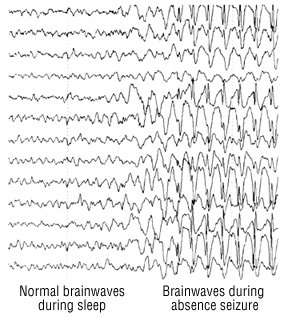Electroencephalogram (EEG)
Medically reviewed by Drugs.com. Last updated on Nov 27, 2023.
What is a Electroencephalogram (EEG)?

An electroencephalogram (EEG) is a recording of the brain's electrical activity. Metal electrodes attached to the skin on the outside of the head transform electrical activity into patterns, commonly called brain waves. A polygraph machine records the brain waves. In some cases, the waves are transmitted to a computer screen. A basic EEG takes about 45 minutes, with a range of 30 minutes to 90 minutes.
|
|
Lightweight EEG devices allow people to walk around and perform normal daily activities while the devices detect and record brain waves over longer periods of time.
What It's Used For
Doctors most often order an EEG to help diagnose a seizure disorder or monitor effectiveness of anti-seizure medicine in people with epilepsy. It also may be used to evaluate someone with confusion, head injuries or other conditions that may be caused by an abnormality in the brain. An EEG can help to diagnose certain types of brain illnesses that cause worsening mental impairment and brain dysfunction, such as encephalopathy caused by severe liver or kidney disease. Occasionally, an EEG may be used to confirm brain death, for example, in someone on life support who is in a deep coma.
Preparation
In most cases, no special preparation is necessary. However, in some people, an EEG gives better results if the recording is obtained after a period of no sleep (sleep deprivation). This makes it more likely that seizures or other abnormalities will occur. If necessary, the doctor will give specific instructions about how and when to limit sleep before the EEG.
How It's Done
You will sit or lie comfortably while a technician attaches a number of small electrodes to your head. The electrodes are not painful. Your scalp will not be shaved, but the area under the electrodes will be cleaned to remove any excess oils from your scalp. A special gel or paste helps the electrodes pick up your brain waves more efficiently.
As the electrodes detect your brain waves and feed them into the EEG machine, several wavy lines (your brain wave patterns) appear on the polygraph's graph paper. As your EEG continues, you will need to open and close your eyes, breathe quickly and deeply, and look at a flashing light. In some people, EEG recording continues as you fall asleep.
Once the EEG is finished, the electrodes are removed and any excess EEG gel or paste is cleaned away. Then you can go home.
Follow-Up
Contact your doctor within a few days to find out the results of your EEG. Otherwise, no specific follow-up is necessary.
Risks
An EEG is a safe procedure. In rare cases, certain people with epilepsy may experience seizures from the flashing lights or the hyperventilating they have to do during the procedure.
When To Call A Professional
Because harmful side effects are not expected, people typically need to call their doctors only for their results.
Additional Info
American Epilepsy Society
https://www.aesnet.org/
American Academy of Neurology (AAN)
https://www.aan.com/
Further information
Always consult your healthcare provider to ensure the information displayed on this page applies to your personal circumstances.

